SWEET CORN OP-ED
/23 Comments/in Vegetables/by Lee ReichAh, the Good Ole’ Days
The good ol’ days seemed to have had snowier winters, greener grass, and more toothsome apples. Perhaps it was so. One thing those good ol’ days definitely did not have was sweeter sweet corn. Only in the past few decades have plant breeders found new genes that shoot the sugar content of sweet corn sky-high.
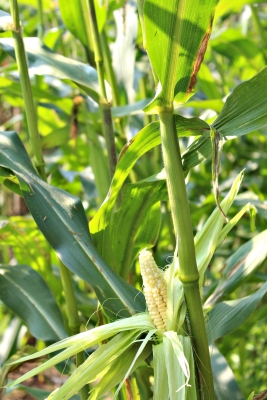
Papoon corn, the first recorded variety of sweet corn, probably originated as a chance mutation of a single gene of field corn. That gene, the so-called sugary gene (abbreviated su), brought the sugar level in corn from four percent up to ten percent.
We gardeners have tried to make the most of that ten percent ever since the time when 18th century Plymouth, Massachusetts gardeners first grew Papoon corn. We pick an ear just when each kernel is creamy and as sweet as can be. Since sugars in corn start changing to starch as soon as the ear is picked, we eat the corn right out in the garden or else rush it to the kitchen to a pot of already boiling water. In only one day, half that sugar will turn to starch.
Quantum Corn
Sweetness in sweet corn took a quantum leap around the middle of the last century as a result of two genes. The first gene, called the shrunken-2 gene (abbreviated sh2) because of the way the dried kernels shrivel up, pushes the sugar level in corn up to a whopping thirty-seven percent. Not only that, but even two days after picking, that corn still has twenty-nine percent sugar.
The variety Illini Xtra Sweet was the first of the appropriately-named “supersweet” sweet corns. Other varieties with this gene are Early Xtra Sweet, American Dream, and SignatureXR. Kernels of these varieties have thick skins and lack a creamy texture.
The second gene responsible for sweeter sweet corn is the “sugar enhanced gene” (abbreviated se). The se gene is effective only in combination with the su gene of regular sweet corn, and the combination of the two genes results in varying degrees of sweetness, typically about twice as sweet as traditional sweet corn, and tender kernels.
Still no need to scurry to the kitchen with se varieties, because they also retain their sweetness for a long time, but only because they start out sweeter. Kandy Korn EH, Sugar Buns EH, Silverado, and Snow Queen EH are varieties with the se gene. Many of these varieties have “EH,” which stands for “everlasting heritage,” in their names.
Juggling genes around to get the best of all worlds resulted in two more hybrid types of corn. “Synergistic” (syn) varieties have some su kernels from traditional sweet corn added to each ear of supersweet (shr) corn, typically about 25%, in an effort to balance sweetness, creaminess of texture, and tenderness. “Augmented sh2” varieties have some se and su genes added to an sh2 parent, basically combining all of the above genes, resulting in more sweetness and less toughness.
In case you’re wondering, none of these varieties are necessarily genetically modified (GM). All can be produced with traditional corn breeding techniques.
What’s Not to Love
Why doesn’t every gardener plant these new sweet corns? (Because of their sweetness and their ability to hang on to it longer after harvest, pretty much every farmer does limit their planting to these newfangled corns these days.) One reason not to plant these varieties is because these varieties need special care. Their seeds are finicky, and will rot just as soon as grow if planted in soils that are too cool, too dry, or too wet. Soil microorganisms also like that extra sweetness. Even after the seeds have been coaxed to germinate, the resulting seedlings often lack vigor.
The sweeter sweet corns can lose almost all their sweetness if the wrong pollen blows onto their silks. Basically, all of the above varieties need to be isolated from all of the other above varieties except for the combination of traditional (su) varieties and sugar enhanced (se) varieties, although cross-pollination between the latter two will dilute full expression of each variety’s characteristics. The only way to minimize contamination between varieties is to separate them by at least 250 feet, or else plant varieties whose maturities differ by more than two weeks.
And what about flavor: Is sweetness all we want from sweet corn? The sweeter sweet corn varieties tend to taste watery and lack a “corny” flavor. If breeders could develop a sweet corn with ninety-five percent sugar, would that be even better?
Corn with thirty-seven percent sugar tastes too sweet to many gardeners. I remember years ago stopping at the farmstand of one of the large local growers and asking them if they had any Golden Bantam, an old fashioned variety of sweet — not supersweet — corn for sale. The farmer’s wife grinned sheepishly and said they grow that variety for themselves.
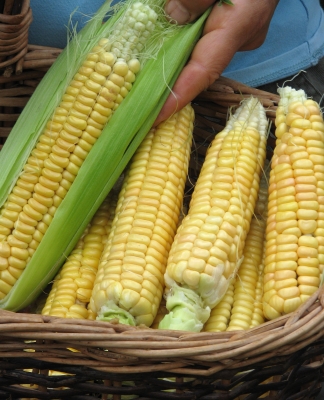
Golden Bantam-m-m-m-m
A milk chocolate bar, with about fifty percent sugar, isn’t all that much sweeter than a supersweet variety of corn, some of which can have as much as 44% sugar.
For some of us, traditional sweet corn varieties — such as, in addition to Golden Bantam, once-popular varieties as Seneca Chief, Stowell’s Evergreen, Country Gentleman, and Silver Queen — are as delicious as corn needs to be if they are picked at just the right stage, then eaten within minutes. Ten percent sugar, especially when coupled with with a rich, corny flavor, and some degree of chewiness, is enough for me.
In the past, I’ve heaped praise on Golden Bantam corn, which was the standard for excellence in sweet corn a hundred or so years ago. I grow only this variety, more specifically “8-row Golden Bantam,” which distinguishes it from many Golden Bantam sired hybrids, such as Golden Cross Bantam and Top Cross Bantam.
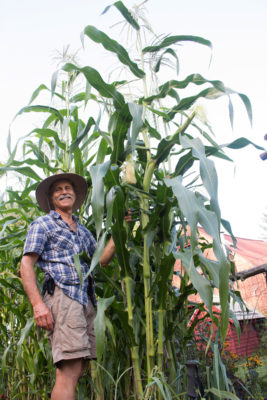
Golden Cross Bantam (not bantam)
Last year I feared I hit a bump in the road with Golden Bantam, as one-quarter of my planting yielded nothing worth harvesting due to what may have been northern corn leaf blight. I went ahead and planted 8-row Golden Bantam again this spring and am happy to say that the corn looks fine.
Four 20 by 3 foot beds, with double rows of “hills” 2 feet apart in each row and 3 plants per hill, provides all our household needs for fresh steamed or roasted ears and frozen kernels for winter.
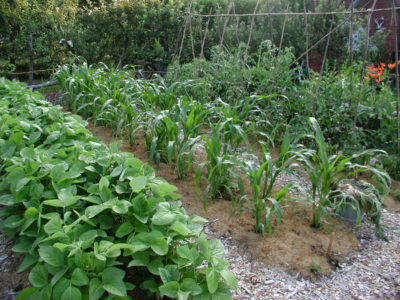
Bed of sweet corn
BEAUTIFUL DESIGN AND UGLY BLIGHT
/16 Comments/in Design, Vegetables/by Lee ReichWho Made This Garden?
I visited a most beautiful garden this week, one in which all the elements of garden design were deftly combined. At ground level groundcovers presented pleasing and harmonious shades of green and varying leaf textures. Leafy plants, lichens, and mosses all contributed to the symphony, the whole scene knit together by large slabs of underlying rock.
In places, low-growing junipers and deciduous shrubs and trees brought the garden up from ground level. Particularly striking was a very large boulder atop of which grew some trees whose exposed roots embraced the boulder before reaching to the ground for water and nourishment. Green moss growing on the boulder erased any starkness from this vignette.
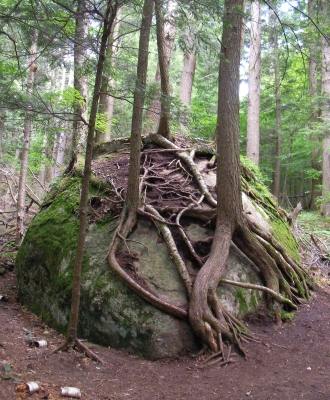
Shakkei, or “borrowed scenery,” an important element in Japanese garden design, played an important role. Distant mountain peaks created a dramatic backdrop in some views.
This garden also utilized what I like to call “luscious landscaping,” that is, the incorporation of dual purpose plants -– for beauty and for eating -– into the landscape. Lowbush blueberry, a plant whose dainty flowers hang like white bells in spring, whose healthy, green foliage ignites in crimson come fall, and whose stems glow red in winter, formed the bulk of the groundcover species. A few lingonberry plants interspersed here and there promised red berries in autumn and evergreen leaves as a foil for those red blueberry stems in winter.
And just where was this wonderful garden? Or gardens, I should say. They were in the high peaks of New York’s Adirondack mountains. The garden designer? God or one described by Darwin, take your pick. Beautiful, at any rate.
Blight Here in the Valley
Back down here on the flatlands, the word “blight” is often bantered around in connection with tomatoes this time of year – your tomatoes, my tomatoes, basically, everybody’s tomatoes! A few years ago, it was late blight (Phytophthera infestans) that was the blight that was of special interest. Attacking both tomatoes and potatoes, this is the same disease that caused the potato famine in Ireland in the 19th century.
Late blight was a problem in the northeast that year due to a particular confluence of events: infected tomato plants offered at “big box” stores gave the blight its start and rainy, humid conditions kept it going.
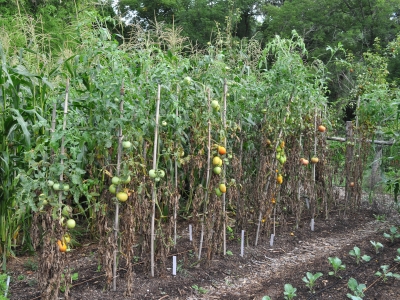
A few years ago; not this year.
The disease does not overwinter here in the north, except on infected potato tubers stored or left in the ground through winter. The way late blight arrives in the north is either on infected transplants or by hitchhiking up from southern fields, where it does overwinter, when weather conditions are just right. The spores can travel about 15 miles at a shot with the right winds coupled with cool, moist weather.
My tomato plants had their usual midsummer splotches and yellowing that year. I usually find pest problems more interesting than scary, I got a little worried about late blight. I tested for it by pulling a splotchy leaf off a plant, sliding it into a plastic bag, and waiting a day. White, fuzzy growth on the leaf would mean late blight. Testing was negative, although blight did eventually show up.
Only under the most severe conditions will I take special measures to control late blight. That year presented those conditions. I decided to spray my tomato plants, a measure to which I’d never before resorted. And it’s not because I grow mostly heirloom tomatoes; pretty much any and every tomato variety is susceptible to late blight. I used one of many copper sprays that are organically approved, still taking care not to dowse nearby other plants and to thoroughly protect myself while spraying.
Blight. What’s That?
That’s not to say all my tomato plants are the pictures of health this year, or any year. They do get some leaf yellowing and loss due to disease. Three diseases, in fact. One is the already mentioned late blight. The other two, which do rear their ugly heads reliably every year, are early blight and septoria leaf spot.
If you look closely at the leaf damage, you can tell which one(s) your tomatoes are hosting. Early blight (Alternaria solani), the most common of the three, marks leaves with dark-brown, round spots a half-inch in diameter, each surrounded by concentric rings.
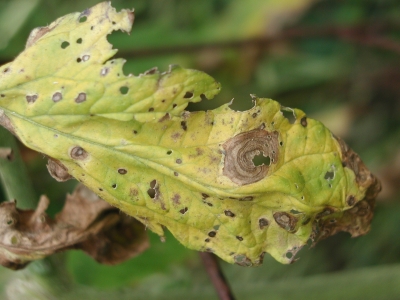
Early blight
Septoria leaf spot (Septoria lycopsersici) causes spots that are small, round and gray, each surrounded by a single, dark margin.
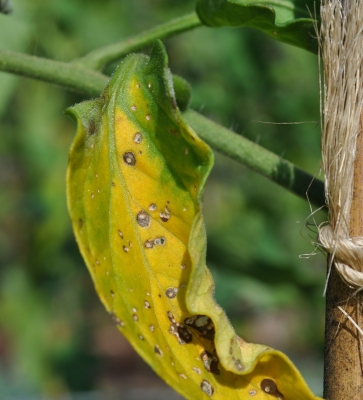
Septoria leaf spot
And late blight causes greenish-black splotches.
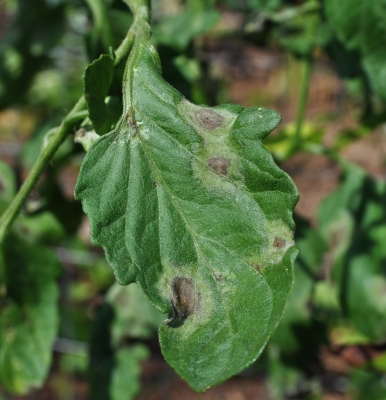
Late blight
The names of any one of the leaf spot diseases is enough to conjure up fear of plague, but fortunately, all three can be lumped together when it comes to control. The first line of defense against any of the leaf-spot diseases is to keep disease spores away from tomato plants. Spores spend the winter in old plant debris, then are awakened and splashed onto new tomato leaves by rain during the growing season. Early blight and septoria spend the winter in old tomato refuse on the ground. Potato tubers can overwinter this far north on stored potato tubers that are planted out for the next season.
All of which makes a good case for a thorough garden cleanup each fall. At the end of the season I load up my garden cart and haul over to the compost pile old tomato and potato stems, leaves, and fruits.
During the growing season, any mulch — my choice is compost — keeps raindrops from splashing spores up onto plant leaves. Removing infected leaves during the growing season may also help control disease spread. I leave leaves intact, figuring more photosynthesis makes for stronger plants (except, of course, for any leaves too far gone to make a significant contribution to the plant).
Crop rotation each year moves tomato plants away from any spores left from the previous season’s crop. Plant tomatoes in a new location in the garden each year, never returning them to the same spot until four years have elapsed — admittedly a tall order in a small garden.
Another line of defense against leaf spot diseases, many diseases for that matter, is to create an environment inhospitable to them. Fungi thrive in dark, moist, humid places. Let plants bask in full sun without obstructions such as weeds, fences, or other garden plants that would slow air circulation.
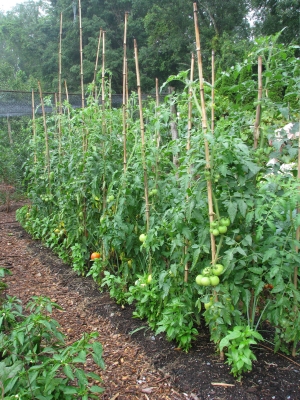
I train each tomato plant to a single stem, which is staked, putting distance between the leaves and any spores on the soil, and exposing the plant to better air circulation. Spaced 18 inches apart, the plants yield less per plant than tomato plants allowed to run wild, but because they utilize a third dimension — up — more tomatoes per land area. Also earlier and with bigger fruits.
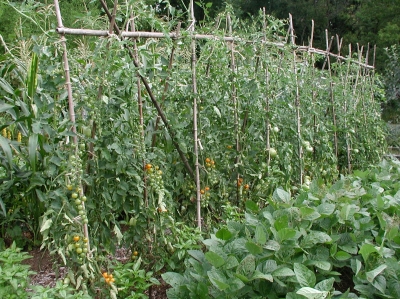
MORE THAN JUST PEACHES AND PLUMS HERE
/9 Comments/in Fruit/by Lee ReichPreiselbeere, Kokemomo, Puolukka, Partridgeberry, Cowberry, Rock cranberry — or Lingonberry, They’re All the Same Fruit.
Besides enjoying the season’s plums and peaches, I’m also enjoying a few uncommon fruits. Uncommon now. These fruits have been enjoyed by humans somewhere at sometime, just not extensively now.
The most familiar of these to most would be lingonberries (Vaccinium vitis-ideae). As jam, in jars, that is, unless you’re Scandinavian, where this fruit is very popular harvested from the wild and then used in drinks, sauces, and pancakes.

Lingonberry, which is native throughout colder regions of the northern hemisphere, is often compared with our native cranberry. I think that does lingonberry an injustice. Both are diminutive plants, spreading as their stems root where they touch the ground, so could be edible groundcovers. Both are evergreen, but while lingonberry’s dainty leaves have the same green gloss as those of holly, and retain it all winter, cranberry leaves turn a muddy purple with the onset of cold weather in late fall.
I recently read that the berries are “not good to eat in their raw state as they are quite bitter.” That writer evidently never tasted lingonberries; I eat them raw all the time and find them delicious. And it’s not because my taste buds are so robust. I’d never pop a cranberry, which is closely related to lingonberry, into my mouth. Too, too sour.
Lingonberry is now ripening fruits — and it’s also blossoming! The plants bloom twice each season, yielding an early and a later crop. 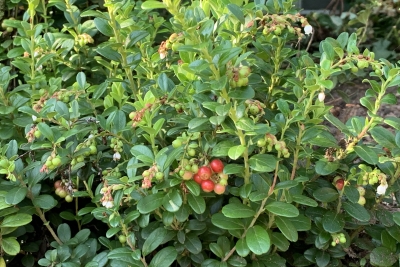 If not harvested, the later crop hangs, looking pretty and in good condition for eating, through autumn and on into winter.
If not harvested, the later crop hangs, looking pretty and in good condition for eating, through autumn and on into winter.

To thrive, the plant needs similar conditions to those enjoyed by blueberry, cranberry, mountain laurel, rhododendron, and other lingonberry relatives. In addition to good drainage and abundant humus, the soil needs to be very acidic, with a pH ideally between 4.5 and 5.5.
Right after planting and then each year thereafter, some time between fall and spring, my lingonberries get mulched with a one- to two-inch depth of some finely divided, organic material that is not too rich in nutrients: sawdust, woodchips, chopped straw, or shredded leaves, for example. The mulch sifts down through the leaves and stems to keep the ground cool and moist, prevent frost from heaving plants in winter, and decompose to maintain high humus levels in the soil — all of which translates to larger berries and more of them.
The plants require little care beyond regular watering for the first couple of seasons.
Centuries of Flavor
Also ripe now is a fruit that has been enjoyed by humankind for the past seven thousand years (although not so much now)! At a site in northern Greece, early Neolithic peoples left traces of their meals of cornelian cherry (Cornus mas), along with remains of einkorn wheat, barley, lentils, and peas. It was also well-known to the ancient Greeks and Romans. The hard wood was reputedly the wood for chariot axles.
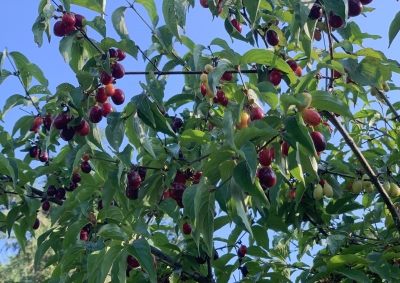
The plant was grown in monastery gardens of continental Europe through the Middle Ages and was introduced to Britain about the sixteenth century. By the eighteenth century, the plant was common in English gardens, where it was grown for its fruits which sometimes were called cornel plums.
The fruit was familiar enough to be found in European markets even up to the end of the nineteenth century. Cornelian cherries were especially popular in France and Germany, and the fruit reputedly was a favorite with children.
Native to regions of eastern Europe and western Asia, the cornelian cherry is still appreciated for its fruit in certain parts of these regions. Baskets of kizilcik, as the Turks call the fruit, are found in markets of Istanbul. The fruit is a popular backyard tree in gardens of Moldavia, Caucasia, Crimea, and the Ukraine.
When the fruit was popular in Britain, it was made into delicious tarts, and shops commonly sold rob de cornis, a thickened, sweet syrup of cornelian cherry fruits. The juice also added pizazz to cider and perry.
Depending on ripeness, fruit flavor varies from sweet to tart. It has a distinctive flavor and can be used in cookery at all stages. If tart fruit is allowed to sit for a day or two or three, the flavor becomes less tart and more mellow.
Cornelian cherry is a favored ingredient of Turkish serbert, a fruit drink sold in stores and from portable containers carried like knapsacks on the backs of street vendors. In the Ukraine, cornelian cherries are juiced, then bottled commercially into soft drinks. There, the fruits also are made into conserves, fermented into wine, distilled into a liqueur, and dried.
The plant is actually not a true cherry, but a species of dogwood. It is still widely, but mostly planted as an ornamental for its very early show of small, yellow blossoms, around the first day of spring here on the farmden.
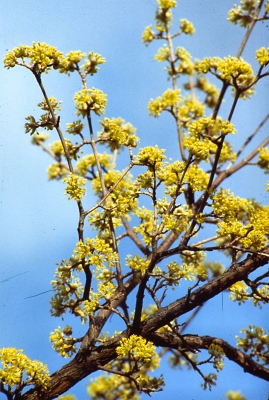
Cornelian cherry is among my most successful fruit crops. Despite its early bloom, it has never failed to bear. Birds, insects, and diseases have little effect on production. Pruning is unnecessary. What else can you ask for from a fruit plant?
(I am still looking for some good recipes that use this fruit and lingonberry for possible inclusion in an update of my book Uncommon Fruits for Every Garden. Got something? Both fruits are covered in my currently available books, Landscaping with Fruit and Grow Fruit Naturally.)
Intoxicatingly Delicious?
This last fruit is very uncommon, and I didn’t plant the tree mostly for its fruit. Hackberry (Celtis occidentalis) bark is gray with corky ridges that, especially in winter when illuminated by low-hanging sunlight, has that crisp, achromatic quality of photographs of the lunar landscape.
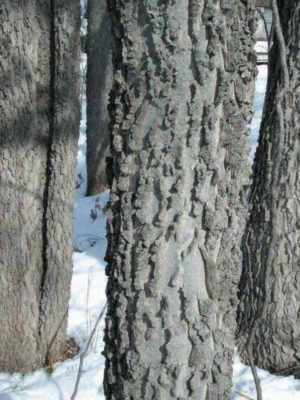
Hackberry bark
The fruit itself is refreshingly sweet, like a date. Problem is that the fruit is pea sized and contains an almost-pea-sized seed. So the fruits nothing more than a thin covering over the seed.
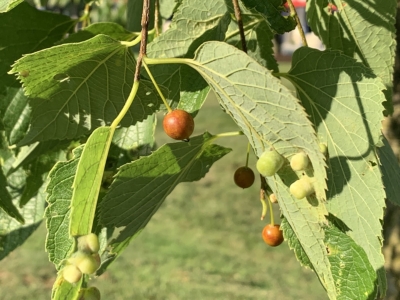
More prominent in the human diet is a close relative, one name of which is the lote tree (C. australis), which even figure in Greek mythology. When Zeuss drove Odysseus’ ships off course, the sailors finally found refuge in the Island of the Lote Eaters. Eating the fruits caused a pleasant drowsiness, to the extent that the sailors, forgetting their homes and friends, wished for nothing more than idling away on the island. Odysseus had to drag them back onto their ships.

The lote tree, native to Europe and temperate regions of Asia, is pretty cold-hardy (Zone 5). I have ordered seeds and should get to taste fruit of the lote tree in a few years. I might never leave the farmden.

